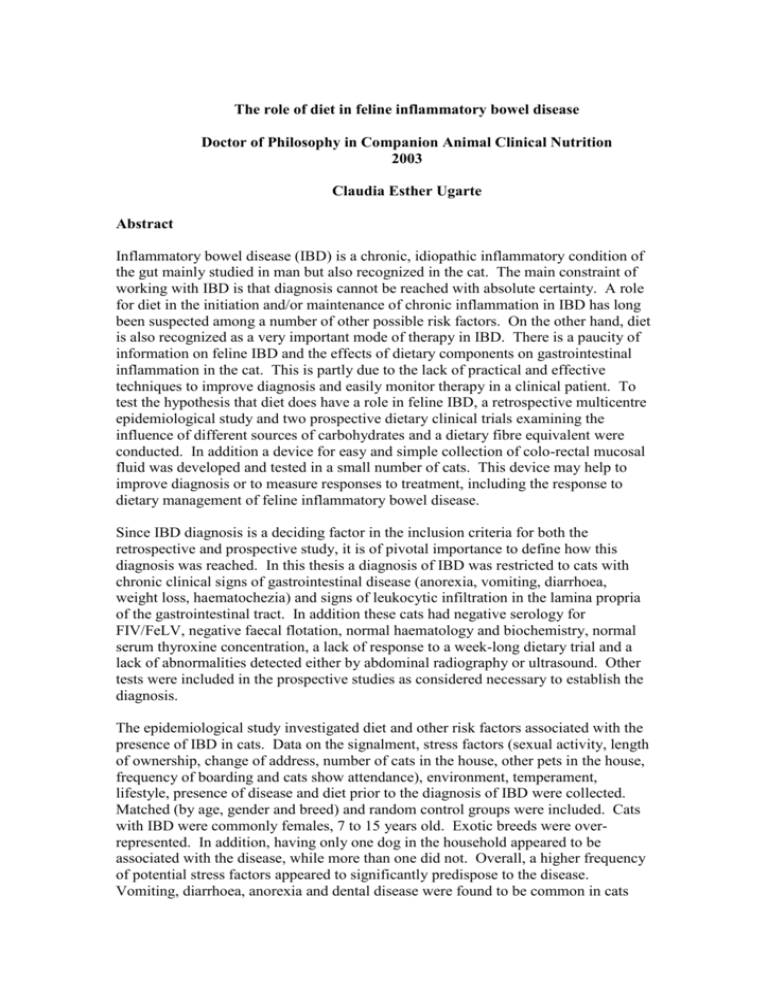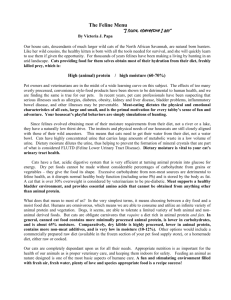MASSEY UNIVERSITY
advertisement

The role of diet in feline inflammatory bowel disease Doctor of Philosophy in Companion Animal Clinical Nutrition 2003 Claudia Esther Ugarte Abstract Inflammatory bowel disease (IBD) is a chronic, idiopathic inflammatory condition of the gut mainly studied in man but also recognized in the cat. The main constraint of working with IBD is that diagnosis cannot be reached with absolute certainty. A role for diet in the initiation and/or maintenance of chronic inflammation in IBD has long been suspected among a number of other possible risk factors. On the other hand, diet is also recognized as a very important mode of therapy in IBD. There is a paucity of information on feline IBD and the effects of dietary components on gastrointestinal inflammation in the cat. This is partly due to the lack of practical and effective techniques to improve diagnosis and easily monitor therapy in a clinical patient. To test the hypothesis that diet does have a role in feline IBD, a retrospective multicentre epidemiological study and two prospective dietary clinical trials examining the influence of different sources of carbohydrates and a dietary fibre equivalent were conducted. In addition a device for easy and simple collection of colo-rectal mucosal fluid was developed and tested in a small number of cats. This device may help to improve diagnosis or to measure responses to treatment, including the response to dietary management of feline inflammatory bowel disease. Since IBD diagnosis is a deciding factor in the inclusion criteria for both the retrospective and prospective study, it is of pivotal importance to define how this diagnosis was reached. In this thesis a diagnosis of IBD was restricted to cats with chronic clinical signs of gastrointestinal disease (anorexia, vomiting, diarrhoea, weight loss, haematochezia) and signs of leukocytic infiltration in the lamina propria of the gastrointestinal tract. In addition these cats had negative serology for FIV/FeLV, negative faecal flotation, normal haematology and biochemistry, normal serum thyroxine concentration, a lack of response to a week-long dietary trial and a lack of abnormalities detected either by abdominal radiography or ultrasound. Other tests were included in the prospective studies as considered necessary to establish the diagnosis. The epidemiological study investigated diet and other risk factors associated with the presence of IBD in cats. Data on the signalment, stress factors (sexual activity, length of ownership, change of address, number of cats in the house, other pets in the house, frequency of boarding and cats show attendance), environment, temperament, lifestyle, presence of disease and diet prior to the diagnosis of IBD were collected. Matched (by age, gender and breed) and random control groups were included. Cats with IBD were commonly females, 7 to 15 years old. Exotic breeds were overrepresented. In addition, having only one dog in the household appeared to be associated with the disease, while more than one did not. Overall, a higher frequency of potential stress factors appeared to significantly predispose to the disease. Vomiting, diarrhoea, anorexia and dental disease were found to be common in cats with IBD before diagnosis. Skin (acne, reaction to insecticide spray, eosinophilic plaque, plasma cell pododermatitis, otitis externa) and respiratory problems (sneezing or coughing) were also more prevalent among cats with IBD. Lifestyle, veterinary care and diet were very variable between countries but none of them proved to be significantly associated with feline IBD. The retrospective nature of epidemiological studies does not allow all possible nutritional associations to be studied. This fact along with the known nutritional idiosyncrasies of feline nutrition provided the logic to investigate diet as a mode of treatment in two prospective dietary trials. One trial involved a comparison of different sources of starch (rice, barley, tapioca and corn 18.4 – 25.8%ME) by healthy cats and cats with IBD. The rationale for this comparison was that cats do not possess all the tools to deal with dietary carbohydrates when compared to other species, and that carbohydrate malabsorption can occur during gastrointestinal inflammation and contribute to the clinical signs of gastrointestinal disease. The other prospective dietary trial tested diets supplemented with different amounts of inulin (0, 0.1 or 0.2%DM). Inulin is an oligosaccharide which effects in the gastrointestinal tract of man and other species resemble the actions of dietary fibre. The products of fermentation of dietary fibre are considered beneficial for colonic health and have been used for the treatment of idiopathic colitis in several species. The study on carbohydrate tolerance was a crossover study that included a control group of healthy cats from a research facility and cats diagnosed with IBD (according to the criteria mentioned above). Breath hydrogen collection, faecal grade and water content, faecal sodium, faecal potassium, faecal osmolar gap and gastrointestinal clinical signs were used to compare carbohydrates. IBD cats showed a higher area under the curve (AUC) of breath hydrogen (p=0.0001) indicating malabsorption of carbohydrate, irrespective of starch source, when compared with healthy controls. No deleterious effects on faecal characteristics, clinical signs or body weight were observed. The faecal osmolar gap did not prove to be useful to identify cats with IBD. Rice increased faecal sodium/potassium ratio when compared with the other starches. In summary, carbohydrate malabsorption seems to be a feature of gastrointestinal inflammation in the cat but in the short term it does not seem to be detrimental in terms of clinical signs or body weight. On the other hand the feline colon appears to have an amazing capacity to maintain water absorption in the midst of an increased load of fermentable material. Hence carbohydrate malabsorption cannot be judged by faecal characteristics in the cat. In addition, the use of rice as the preferred carbohydrate for dietary management of feline IBD may need to be further examined since the AUC when consuming rice was similar or higher than with the other sources of starch. The significance of the finding that the rice based diet was associated with an increase in faecal sodium is uncertain. The inulin study was conducted in healthy cats (20 belonging to a research facility and 10 owned by the public) and a small number of cats with IBD. Changes in microdissection parameters (number of dividing cells per crypt, number of epithelial cells per crypt cell column, crypt length, crypt width and crypt area) in the duodenum, colon and rectum were studied as well as changes in histological preparations, transit of radiopaque markers and macronutrient digestibility. The addition of inulin to feline diets was associated with an increase in the number of epithelial cells per colonic crypt (p=0.006) and colonic crypt length (p=0.025) after the cats ate the diets supplemented with inulin for four weeks with no indication of a dose response to inulin. There was also a trend towards a greater number of dividing cells in duodenal (p=0.07) and colonic ((p=0.07) crypts in publicly owned cats consuming the diet with 0.2% inulin. Much variation was found between research colony cats and publiclyowned cats before the trial started. The addition of inulin was not detrimental to faecal characteristics, macronutrient digestibility and did not cause any change in the transit of radiopaque markers in healthy cats. The increase in crypt cellularity in healthy cats is a potentially beneficial effect for the treatment of colitis but further research in cats with clinical colitis is required.





